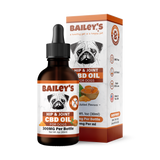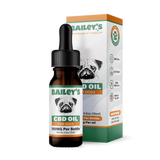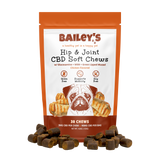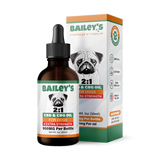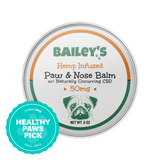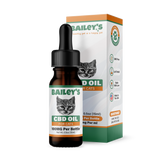Dog Panting in Car: Causes and Solutions
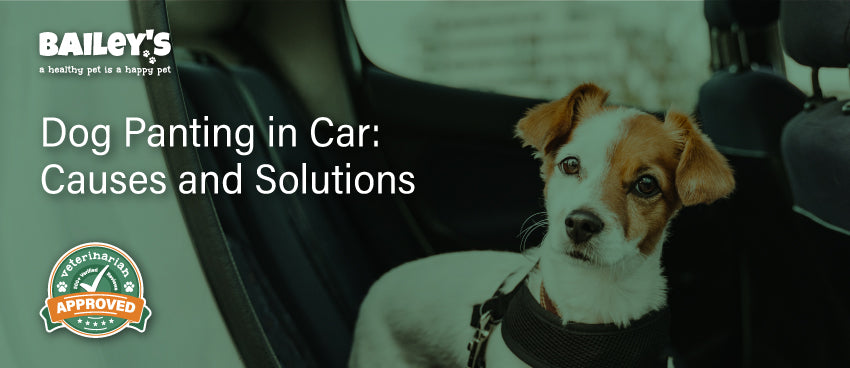
If you're a dog owner, you've likely seen your furry friend panting during car rides. Although sometimes a concern, it's important to recognize that dog panting is often a natural reaction. The experts at Bailey’s CBD are ready to guide us through understanding the causes of this behavior and offer solutions to ensure your dog's comfort and tranquility during travel.

Table of Contents
1. Understanding Dog Panting
Dog panting is a vital function that allows canines to regulate their body temperature. Unlike humans, dogs do not sweat as a primary means of cooling down. Instead, they rely on panting to release excess heat. This process involves rapid and shallow breaths, which help to evaporate moisture from their tongue and respiratory tract.
When a dog pants, they take in large amounts of air, which then passes over their mucus membranes and tongue. This airflow promotes the evaporation of moisture, resulting in cooling effects. Additionally, dog panting aids in oxygen exchange, ensuring an adequate supply of fresh oxygen to the body.
But let's dive deeper into the physiology of dog panting. When a dog starts to pant, their respiratory rate increases significantly. This increased breathing rate allows for a higher volume of air to enter the lungs. As the air passes over the moist surfaces of the tongue and respiratory tract, it picks up moisture, which then evaporates into the surrounding air. This evaporation process helps to dissipate heat from the dog's body, effectively cooling them down.
Furthermore, dog panting serves as a mechanism for oxygen exchange. As dogs pant, they not only expel warm air but also take in the fresh air. This exchange of air ensures that the dog's body receives a constant supply of oxygen, which is vital for various physiological processes.
1.1 Normal vs. Abnormal Panting in Dogs
While panting is generally a normal behavior in dogs, it's crucial to differentiate between normal and abnormal panting. Normal panting occurs after physical exertion, during hot weather, or when dogs are excited. It is a natural response to regulate body temperature and is usually not a cause for concern.
On the other hand, abnormal panting may be a sign of a medical condition or distress. If a dog is panting excessively without any apparent reason, it could indicate an underlying health issue. Some potential causes of abnormal panting include heatstroke, respiratory problems, pain, anxiety, or even certain medications.
Dog owners need to monitor their pets' panting patterns and seek veterinary attention if they notice any significant changes. Excessive or labored panting, especially accompanied by other symptoms such as lethargy, coughing, or difficulty breathing, should never be ignored.
In conclusion, dog panting is a fascinating physiological process that plays a crucial role in regulating body temperature and ensuring proper oxygen exchange. Understanding the difference between normal and abnormal panting can help dog owners provide appropriate care and seek timely veterinary assistance when needed.
2. Common Causes of Dog Panting in Cars
Several factors can cause dogs to pant excessively while in cars. Understanding these causes can help you address the underlying issue and make car rides more pleasant for your four-legged friend.
2.1 Anxiety and Stress-Related Panting
For some dogs, car rides can trigger anxiety and stress. This anxiety may stem from previous negative experiences, motion sickness, or a general fear of car travel. When dogs are anxious or stressed, they may exhibit panting as a physiological response to the perceived threat.
Imagine your dog, sitting in the backseat, panting heavily as you drive down the road. You may wonder what could be causing this behavior. Perhaps your furry friend had a traumatic experience in the car, such as a sudden stop or a loud noise. These past experiences can create a sense of fear and unease, leading to excessive panting.
Additionally, some dogs are prone to motion sickness, which can further contribute to their anxiety during car rides. The combination of movement and unfamiliar stimuli can make them feel nauseous and uncomfortable, causing them to pant excessively.
2.2 Overheating and Dehydration
Hot cars can quickly become dangerous for dogs, especially during hot weather. Dogs are more prone to heat exhaustion and heat stroke, as they have a limited ability to regulate their body temperature. If your dog is panting excessively in the car, it may be a sign of overheating or dehydration.
Picture this: you're driving on a scorching summer day, and your beloved pup is panting heavily in the backseat. The temperature inside the car can rise rapidly, putting your furry friend at risk of overheating. Dogs rely on panting as a way to cool down, as they don't sweat like humans. Excessive panting in the car could be a cry for help, indicating that your dog is struggling to cope with the heat.
In addition to overheating, dehydration can also be a concern. Dogs need access to fresh water to stay hydrated, especially during car rides. If your dog is panting excessively, it may be a sign that they are thirsty and in need of a drink. Providing water breaks during long car journeys can help prevent dehydration and make the ride more comfortable for your furry companion.
2.3 Motion Sickness in Dogs
Just like some humans, dogs can experience motion sickness during car rides. The combination of movement and unfamiliar stimuli can trigger nausea and discomfort, leading to excessive panting. Motion sickness can cause distress and make car rides an unpleasant experience for your canine companion.
Imagine your dog eagerly jumping into the car, excited for an adventure. However, as soon as the wheels start turning, your furry friend starts panting excessively and looking visibly uncomfortable. This could be a sign of motion sickness. Dogs with motion sickness may drool, vomit, or exhibit excessive panting as their body reacts to the motion and sensory overload.
It's important to note that motion sickness can affect dogs of all ages, from puppies to seniors. If your dog experiences motion sickness, there are strategies you can try to alleviate their discomfort, such as using calming aids, gradually acclimating them to car rides, or consulting with your veterinarian for further guidance.
3. Recognizing the Signs of Distress in Your Dog
It's essential to be able to recognize the signs of distress in your dog, especially during car rides. Observing these signs will help you understand when your dog is feeling uncomfortable or anxious and allow you to take appropriate action.
Dogs, like humans, can experience various levels of distress. While some dogs may handle car rides with ease, others may find them extremely stressful. It's important to be aware of the signs that indicate your furry friend is not enjoying the journey.
3.1 Excessive Panting and Drooling
Excessive panting and drooling are common signs of distress in dogs. If your dog is panting heavily with excessive drooling during car rides, it may indicate that they are feeling anxious, fearful, or unwell.
Panting is a normal behavior for dogs, especially when they are hot or after physical exertion. However, if your dog is panting excessively and drooling excessively during car rides, it's a clear indication that something is amiss. It could be a result of anxiety or motion sickness, and it's crucial to address the issue promptly.
3.2 Changes in Behavior and Body Language
Observe your dog's behavior and body language while in the car. Signs of distress may include pacing, trembling, whining, or hiding. Your dog may also exhibit signs of restlessness, such as an inability to sit or lie down comfortably.
Behavioral changes are often the most noticeable signs of distress in dogs. If your typically calm and composed dog starts pacing back and forth or whining incessantly during car rides, it's a clear indication that they are not enjoying the experience. Similarly, if your dog trembles or hides in the car, it's a sign that they are feeling overwhelmed and anxious.
Restlessness is another common sign of distress. Your dog may struggle to find a comfortable position to sit or lie down in the car, constantly shifting their weight or fidgeting. This restlessness can be a result of anxiety or discomfort, and it's important to address it to ensure your dog's well-being.
4. Preventative Measures for Dog Panting in Cars
Fortunately, there are several steps you can take to prevent or minimize dog panting in cars, ensuring a safer and more enjoyable travel experience for both you and your canine companion.
4.1 Conditioning and Training Your Dog for Car Rides
Introduce your dog to car travel gradually and positively. Start by allowing them to explore the car while parked, associating it with positive experiences such as treats and praise. Gradually progress to short drives, rewarding your dog for calm behavior. This conditioning will help reduce anxiety and make car rides more comfortable.
4.2 Ensuring Proper Ventilation and Temperature
It's crucial to maintain a comfortable temperature and proper ventilation inside the car. Keep windows cracked or use a dog-approved car window vent to ensure a steady flow of fresh air. Avoid leaving your dog unattended in a parked car, especially in hot weather, as this can lead to overheating and distress.
4.3 Hydration and Rest Stops During Long Trips
When embarking on long car trips, ensure your dog stays hydrated and takes regular rest stops. Offer small amounts of water at rest stops and encourage your dog to drink. Plan frequent breaks to allow your canine companion to stretch their legs, relieve themselves, and have a moment of relaxation.

5. Solutions for Dog Panting in Cars
If your dog continues to pant excessively despite preventative measures, there are various solutions available to ease their distress and make car rides more enjoyable.
5.1 Anxiety Reducing Techniques and Tools
Implement anxiety-reducing techniques such as desensitization and counter-conditioning. Gradually expose your dog to car rides while engaging in calming activities, such as playing soothing music or providing them with a familiar blanket or toy. Additionally, consider using anxiety-reducing tools like Thundershirts or calming pheromone sprays.
5.2 Cooling Products for Dogs
To combat overheating during car rides, consider using cooling products designed for dogs. Cooling pads, mats, or vests can help regulate your dog's body temperature and provide relief from excessive panting.
5.3 When to Consult a Veterinarian
If your dog's panting persists despite trying various solutions, it's essential to consult with a veterinarian. Excessive or abnormal panting may be a sign of an underlying medical condition, such as heart or respiratory problems. A veterinarian can conduct a thorough examination and provide appropriate guidance and treatment.


